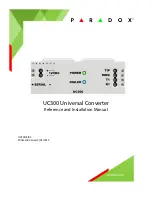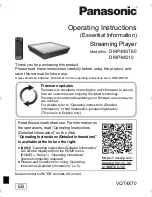
16
User’s Guide M-32 AD
© RME
In internal clock mode it is mandatory that the clock rate of the source is synchronous to the
M-32 AD. Therefore the external device has to be synchronized by the M-32 AD’s word
clock output or ADAT/MADI output.
The M-32 AD thus has to be master, all devices connected to it have to be in slave mode. In
order to avoid clicks and drop outs due to faulty or missing synchronicity, a special process
called
SyncCheck
compares the incoming data and the M-32 AD’s internal clock. The SYNC
state is indicated by a flashing (error) or constantly lit (OK) LED.
The key
STATE
is used to configure the M-32 AD, and with this all of its outputs, to the fre-
quency ranges Single Speed, Double Speed or Quad Speed.
No LED (Single Speed)
All outputs carry a signal in the range of 32 kHz up to 48 kHz.
DS (Double Speed)
64 kHz up to 96 kHz. ADAT and MADI stay at no higher than 48 kHz, with the data transmitted
in the S/MUX format. Therefore ADAT is limited to 16 channels (4 per optical output) in this
mode. In case MADI OUTPUT has been set to 96k frame, the MADI output also uses 96 kHz,
but is still limited to 32 channels.
QS (Quad Speed)
176.4 kHz up to 192 kHz. MADI stays at no higher than 48 kHz, with the data transmitted in the
S/MUX4 format. Therefore ADAT is limited to 8 channels (2 per optical output) in this mode.
MADI is limited to 16 channels.
Follow Clock
Follow Clock automatically configures the Clock State, setting the unit into Single Speed, Dou-
ble Speed or Quad Speed operation.
Activation: during display of the firmware version press the CLOCK STATE button. Both LEDs
DS/QS light up. Deactivation: same, both LEDs stay dark.
Word
: In Follow Clock mode the M-32 AD follows the word input clock automatically over all
three ranges. So at 96 kHz the DS LED automatically lights up, at 192 kHz the QS LED. A man-
ual configuration via the STATE button is not required.
MADI
: The format 48 kHz Frame does not allow for a detection of the current sample rate ran-
ge, therefore an activated Follow Clock will have no effect. A change to Double Speed is per-
formed when MADI is present in 96 kHz Frame format, then a manual configuration via the
STATE button is not required. Additionally the unit remembers the MADI OUTPUT FRAME 96K
setting, and activates it again when 96k Frame is found at the input.
ADAT
: A change to Double Speed is performed when the ADAT Signal includes the Double
Speed flag. Then a manual configuration via the STATE button is not required. A Quad Speed
flag does not exist, so no change will be performed automatically. In case the clock source
sends the DS flag even at Single Speed, Follow Clock has to be deactivated.
Summary of Contents for M-16 AD
Page 5: ...User s Guide M 32 AD RME 5 User s Guide M 32 AD M 16 AD General...
Page 13: ...User s Guide M 32 AD RME 13 User s Guide M 32 AD M 16 AD Usage and Operation...
Page 21: ...User s Guide M 32 AD RME 21 User s Guide M 32 AD M 16 AD Inputs and Outputs...
Page 28: ...28 User s Guide M 32 AD RME...
Page 29: ...User s Guide M 32 AD RME 29 User s Guide M 32 AD M 16 AD Technical Reference...
Page 40: ...40 User s Guide M 32 AD RME 17 Block Diagram M 32 AD...
Page 41: ...User s Guide M 32 AD RME 41 18 Block Diagram M 16 AD...
Page 47: ...User s Guide M 32 AD RME 47 User s Guide M 32 AD M 16 AD Application Examples...
Page 55: ...User s Guide M 32 AD RME 55...















































